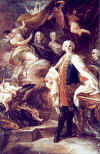|
CENTRO STUDI FARINELLI |
Il Farinelli a Bologna , a cura di Luigi Verdi, Centro Studi Farinelli, Bologna 1998. On the occasion of the exhibition “Corrado Giaquinto: Ritratto di Carlo Broschi detto Farinelli” edited by Beatrice Buscaroli Fabbri (Musei Civici d'Arte Antica), at the Collezioni Comunali d’arte di Bologna (30 giugno-25 ottobre 1998). Reprint in "Nuova Rivista Musicale Italiana", XXXVII, VII nuova serie, 2, aprile-giugno 2003, pp.29-87sti a Bologna
 During
his brilliant career, Carlo Broschi named Farinelli (1705-1782) performed in
Bologna several times: the first time, in the summer 1727, when he was only 22
years old, he interpreted the role of Ceraste in Antigona by Orlandini,
competing in skill with Antonio Bernacchi, a master of the Bolognese chant
school. Patronized by count Sicinio Pepoli, he held a close correspondence,
partly kept at the Archivio di Stato in Bologna (68 letters), with the Bolognese
nobleman. On 6 July 1730, Farinelli and his brother Riccardo Broschi were
admitted to the Accademia Filarmonica of Bologna as honorary members. Back to
Bologna in 1731 with Farnace by
Porta and in 1733 with Siroe by Hasse, Farinelli was conferred the Bolognese
citizenship in October 1732 and a month later he purchased an estate outside
Porta Lame, with the intention of building a villa where to spend his old age
after retiring from the scenes. After a long staying in Spain, Farinelli settled
in Bologna definitely on 19 August 1761, remaining there until his death, on 16
September 1782. In his magnificent villa in Via Lame 228 (today Via Zanardi 30)
and in his town residence in Santa Margherita 1432 (today 6), he used to live
with his small court of artists, cultivating
connections with the most influential European courts. The precious
belongings and the extraordinary
musical archives collected by Farinelli were lost after his death and his
magnificent villa was demolished in 1949, after having been the seat of the
offices of a sugar-refinery (as documented at the Archives of the Soprintendenza
per i beni ambientali e architettonici in Bologna): today that site corresponds
to the Head Offices of the Post. Farinelli was buried in the Church of Santa
Croce of the Convento dei Cappuccini which, on the arrival of the French at the
end of the 1700s, was suppressed to make room for Villa Revedin. In 1810, the
mortal remains of Farinelli were transferred to the Certosa in Bologna: the funeral
monument, still at the Certosa, dates back to 1845 and was provided by
Farinelli’s niece, Maria Carlotta Pisani, Among the Bolognese documents, it is
worthwhile mentioning Farinelli’s Will
(20 February 1782) and the complete inventory of his immense wealth (2 Many
1783), kept at the Archivio di Stato in Bologna, 139 autograph letters from
Metastasio to Farinelli (written between 1747 and 1782) presented to the
University Library in Bologna by his niece Carlotta Pisani, the
volume Descripciòn del estado actual del Real Theatro del Buen Retiro,
kept at the Real Collegio di Spagna and the autograph aria Che Chiedi? Che
brami?, at the Civico Museo Bibliografico Musicale.
During
his brilliant career, Carlo Broschi named Farinelli (1705-1782) performed in
Bologna several times: the first time, in the summer 1727, when he was only 22
years old, he interpreted the role of Ceraste in Antigona by Orlandini,
competing in skill with Antonio Bernacchi, a master of the Bolognese chant
school. Patronized by count Sicinio Pepoli, he held a close correspondence,
partly kept at the Archivio di Stato in Bologna (68 letters), with the Bolognese
nobleman. On 6 July 1730, Farinelli and his brother Riccardo Broschi were
admitted to the Accademia Filarmonica of Bologna as honorary members. Back to
Bologna in 1731 with Farnace by
Porta and in 1733 with Siroe by Hasse, Farinelli was conferred the Bolognese
citizenship in October 1732 and a month later he purchased an estate outside
Porta Lame, with the intention of building a villa where to spend his old age
after retiring from the scenes. After a long staying in Spain, Farinelli settled
in Bologna definitely on 19 August 1761, remaining there until his death, on 16
September 1782. In his magnificent villa in Via Lame 228 (today Via Zanardi 30)
and in his town residence in Santa Margherita 1432 (today 6), he used to live
with his small court of artists, cultivating
connections with the most influential European courts. The precious
belongings and the extraordinary
musical archives collected by Farinelli were lost after his death and his
magnificent villa was demolished in 1949, after having been the seat of the
offices of a sugar-refinery (as documented at the Archives of the Soprintendenza
per i beni ambientali e architettonici in Bologna): today that site corresponds
to the Head Offices of the Post. Farinelli was buried in the Church of Santa
Croce of the Convento dei Cappuccini which, on the arrival of the French at the
end of the 1700s, was suppressed to make room for Villa Revedin. In 1810, the
mortal remains of Farinelli were transferred to the Certosa in Bologna: the funeral
monument, still at the Certosa, dates back to 1845 and was provided by
Farinelli’s niece, Maria Carlotta Pisani, Among the Bolognese documents, it is
worthwhile mentioning Farinelli’s Will
(20 February 1782) and the complete inventory of his immense wealth (2 Many
1783), kept at the Archivio di Stato in Bologna, 139 autograph letters from
Metastasio to Farinelli (written between 1747 and 1782) presented to the
University Library in Bologna by his niece Carlotta Pisani, the
volume Descripciòn del estado actual del Real Theatro del Buen Retiro,
kept at the Real Collegio di Spagna and the autograph aria Che Chiedi? Che
brami?, at the Civico Museo Bibliografico Musicale.
Click here to request the complete text
